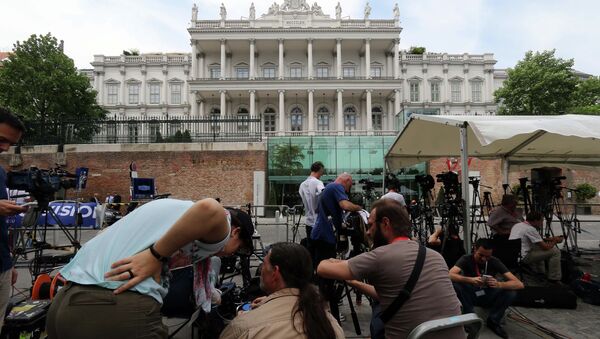VIENNA (Sputnik), Andrei Zolotov, Jr. — The four-storey Palais Coburg, built by the British Queen Victoria’s uncle over the 16th century bastion to eventually house Soviet soldiers in 1945, has always found itself at the crux of war, peace and great power politics.
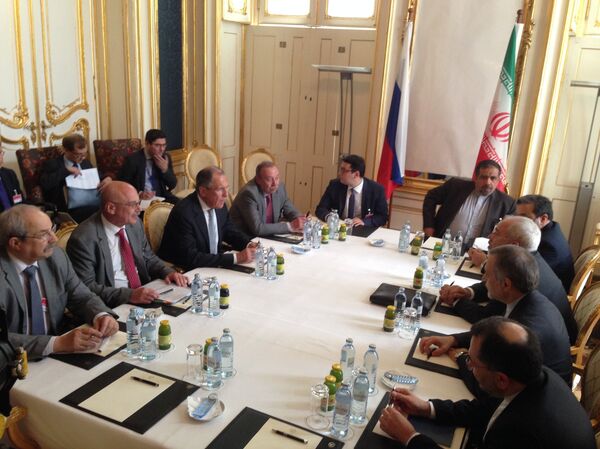
What is today a luxury hotel near the famed Ringstrasse Boulevard was built in 1840-45 by Duke Ferdinand Georg August of Saxe-Coburg and Gotha, a cavalry general in the Austrian imperial army and a proud representative of one of Europe’s preeminent aristocratic families.
According to the family tree adorning the room where reporters waited Monday for a meeting between Russian and Iranian foreign ministers, Sergei Lavrov and Mohammad Javad Zarif, while this palace was in construction, Ferdinand’s niece and nephew – Queen Victoria and Prince Albert (yes, they were first cousins) – lived their first years of matrimony known for granting nine offspring to European kingdoms of the time.
Other branches of the House of Saxe-Coburg and Gotha included the rulers of Belgium, Portugal and Bulgaria. And while the British monarchy chose to change its German name to the House of Windsor amid the peril of the World War One, Bulgaria’s last Tsar Simeon bore the name Sakskoburggotski as the country’s prime minister just a decade ago.
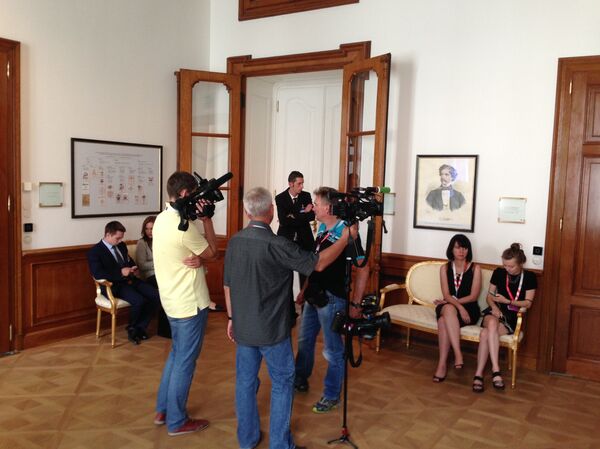
Yet the history of the palace goes back much further than the 19th century. The late classicist palace nicknamed by the Viennese “Spargelburg”, or Asparagus Castle, for two levels of somewhat disproportional columns and half-columns of its facade, stands on the ramp of the Brown Bastion of Vienna's city walls that had protected the capital of the Holy Roman Empire during two sieges by the Turks – in the 16th and in the late 17th centuries.
The victory over the Ottoman Empire in 1683 won at these walls by the Polish-Lithuanian King Jan Sobieski is traditionally seen as the great feat of saving the European Christian civilization from the Eastern Islamic onslaught. The giant white tent put up these days outside Palais Coburg to give working space to hundreds of journalists from around the world covering the talks, looks eerily similar to the Turkish tents surrounding the city walls during the siege as they are depicted in numerous paintings exhibited in Vienna museums.
But the siege of 1683 was the last time the city walls served any military purpose. They proved useless already during the Napoleonic wars when Vienna surrendered to the Grande Armée without a fight. When Emperor Franz Joseph decreed in 1857 to knock down the walls, fill the moat and build in their place the splendid Ringstrasse Boulevard, it was the palace standing atop the Brown Bastion that saved at least part of it from demolition.
So, the vaulted Casemate chambers going several floors below Palais Coburg are today the only a spatial remnant of that grandiose fortification. As they are, the Iran nuclear talks are taking place – literally – on what was once a giant powder keg.
In one of these old red brick-walled chambers below the ground level, next door to the world’s richest wine cellar, some of the negotiators’ meetings took place. It was in this crypt that in the middle of the night on November 30th last year, when the original deadline for reaching the agreement expired, hundreds of reporters were jammed to hear the EU’s High Representative Catherine Ashton and Iran’s Foreign Minister Zarif announce that the talks would be extended for another several months.
It is hard to say whether France’s Foreign Minister Laurent Fabius and his delegation take pleasure in seeing the heraldry of the “Citizen King” Louis Philippe alongside those of the Saxe-Coburg in the elaborate rooms of the palace’s main floor where most ministerial meetings take place.
It was refurbished when the builder’s son, August of Saxe-Coburg-Kohary and his wife, the French king’s daughter Clementine of Orleans, were going to move in.
Yet the princely owners from the outset rented out parts of the building, as if foretelling its future as a hotel. So says the hefty volume on Palais Coburg’s history which is available at the front desk, but stays totally ignored by the overworked diplomats, journalists and security personnel who populate the hotel lobby during the talks.
According to this book, the palace was damaged by Soviet artillery during the battle of Vienna in April 1945. But it survived and for the next 10 years, when Austria was occupied by the Allied Forces, served as a barrack for Soviet soldiers. In 1948 it even offered an exhibition dedicated to the 800th anniversary of the city of Moscow.
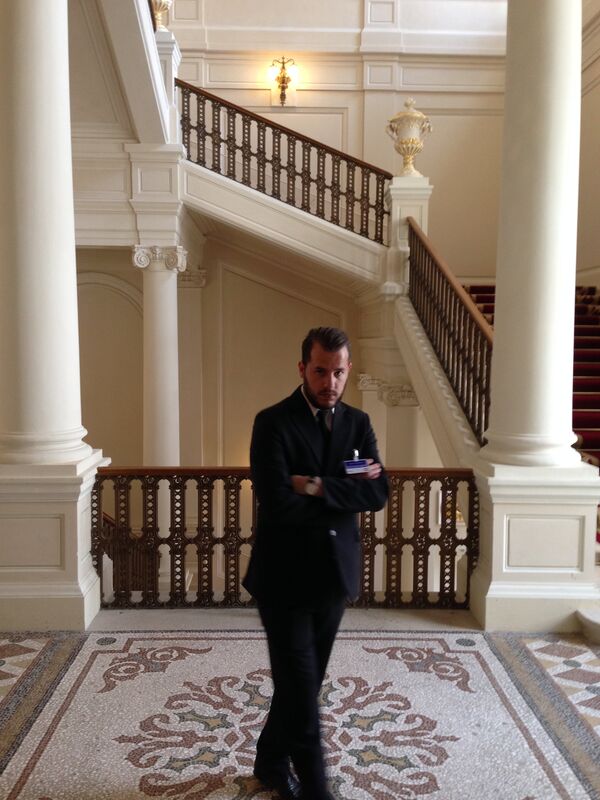
But the palace remained the property of the Saxe-Coburg family until 1978 and its last princely owner, Sarah Aurelia of Saxe-Coburg-Kohary lived here until 1994 after having sold the dilapidated property to a real estate speculator.
At this time, capitalism arrived here in gusto, and the building was re-sold by several banks until it landed in 1997 in the hands of one of Austria’s richest property kings Peter Pühringer.
His firm renovated the building and turned it into Palais Coubrg Residenz hotel that we know today. Double suites here on a weekend in late August are offered on Booking.com at the price range of 595 to 1395 euros per night. The city rumor has it that until the nuclear talks began here in February 2014, the business was not very profitable and the owners considered selling it – so much so that a wealthy Russian businessman-politician took interest in buying.
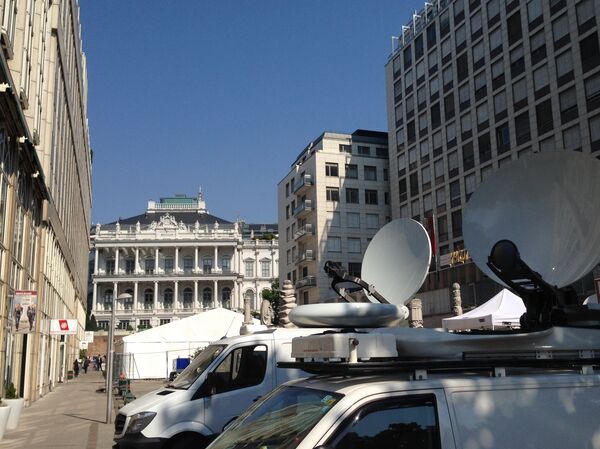
But whatever the commercial worth of the building is, history is once again being made today in Palais Coburg. If the nuclear deal is reached here by Iran and the group of United States, Britain, France, Germany, Russia and China after 16 months of tireless negotiations, the Asparagus Castle will be marked in Vienna guidebooks as another place where the global diplomacy triumphed – just like the Chancellery where the Congress of Vienna met in 1815, the Belvedere Palace where the Allied foreign ministers signed the State Treaty restoring Austria’s sovereignty in 1955, or Hofburg where U.S. President Jimmy Carter and Soviet leader Leonid Brezhnev signed the SALT-II treaty in 1979.
